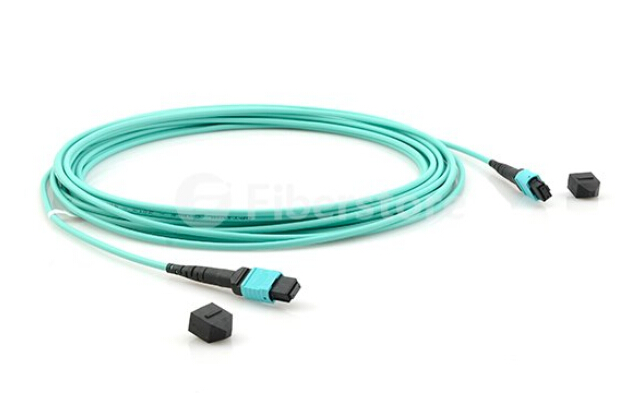MPO trunk cables
(see the picture below) have become the common cabling solution for the
ever increasing data center bandwidth requirements. The MPO fiber cable
links have the features of parallel transmission and they are compact,
pre-terminated, able to handle bandwidth all the way up to 100 Gbps, and
even plug and play by design. The testing, certification and migration
of the MPO fiber cables could be a nightmare though they have these
advantages. This article will focus on the MPO cables testing in the
data center.

The standard testing process of fiber cables can be time consuming, error prone, and once you throw polarity of all 12 fiber connections into the mix, almost a hit-and-miss manual affair. And if you migrate from 10 Gbps to 40/100 Gbps, you need to test and validate performance all over again.
Challenges of MPO Cables
In
order to get a better understanding about the challenges of MPO cable
validation, it is essential to understand MPO cables and how they are
tested. An MPO connection is about the size of a fingernail and contains
12 optical fibers, each less than the diameter of a human hair, and
each one needs to be tested separately. The actual fiber test is quick
enough, typically under 10 seconds per fiber once you’re in process.
The
challenge is that pre-terminated fiber is only guaranteed good as it
exists in the manufacturer’s factory. It must then be transported,
stored, and later bent and pulled during installation in the data
center. All kinds of performance uncertainties are introduced before
fiber cables are deployed. Proper testing of pre-terminated cables after
installation is the only way to guarantee performance in a live
application. Testing and determining fiber polarity is another
challenge. The simple purpose of any polarity scheme is to provide a
continuous connection from the link’s transmitter to the link’s
receiver. For array connectors, TIA-568-C.0 defines three methods to
accomplish this: Methods A, B and C. Deployment mistakes are common
because these methods require a combination of patch cords with
different polarity types.
More Bandwidth, More Testing
The
use of MPO cables for trunking 10G connections in the data center has
steadily risen over the past years. That trunking requires use of a
cassette at the end of the MPO cable designed to accommodate legacy
equipment connections. Now the 40G and 100G connections are coming on
the market. So a migration path has emerged: remove the 10G cassette
from the MPO cable and replace it with a bulkhead accommodating a 40G
connection. Then it might be possible to remove that bulkhead and do a
direct MPO connection for 100 Gbps.
The
problem is that while this migration strategy is an efficient way to
leverage the existing cabling, in comparison to 10G connection, the 40G
and 100G standards call for different optical technology (parallel
optics) and tighter loss parameters. In all, you need to verify the
links to ensure the performance delivery the organization requires when
you have a migration for your network.
Proper MPO Testing
What
would a proper MPO test look like? The answer is simple. Test all 12
fibers—the whole cable—simultaneously and comprehensively (including
loss, polarity). That sort of test capability changes the fiber
landscape, enabling installers and technicians to efficiently validate
and troubleshoot fiber—flying through the process by tackling an entire
12-fiber cable trunk with the push of a button.
The
tools to perform this type of test are emerging on the market, and
promise to reduce the time and labor costs up to 95% over individual
fiber tests. Characteristics to look for in such a tool include the
following parts.
- An onboard MPO connector to eliminate the complexity and manual calculations associated with a fan-out cord.
- A single "Scan All" test function that delivers visual verification via an intuitive interface for all 12 MPO fibers in a connector.
- Built-in polarity verification for end-to-end connectivity of MPO trunk cables.
- "Select Individual Fiber" function that enables the user to troubleshoot a single fiber with more precision.
Demand
for fast and reliable delivery of critical applications is driving data
center technology to evolve at an ever increasing pace. And the
insatiable need for bandwidth ensures that the integrity of the data
center has become inextricably linked to the strength of the fiber
cabling infrastructure. The growing use of MPO trunk cables means that
it’s time to stop the cumbersome verification of individual fibers.
After all, it’s a single MPO connection. You should be able to test the
MPO connection as a whole.
Article source: www.fiberopticshare.com/introduction-to-mpo-fiber-testing.html
没有评论:
发表评论